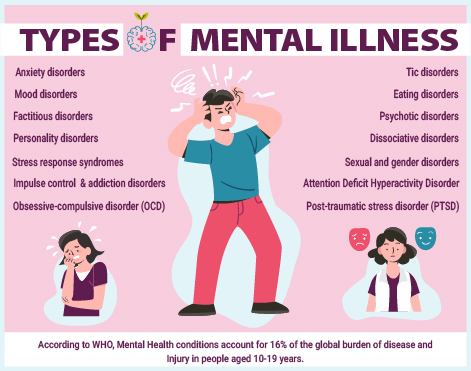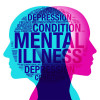
Written By:
 Dr. Ambika Kapoor
Dr. Ambika Kapoor
 Dr. Ambika Kapoor
Dr. Ambika Kapoor
Published On: 24 Mar, 2021 2:31 PM | Updated On: 16 Sep, 2025 3:14 PM
14 Types of Mental Illness - You should know about
Types Of Mental Illness | Warning Signs of Mental Illness
Mental illness: A stigma or a real problem?
Each individual gets "sad" or "blue" at times in his life, and we sometimes make a joke about people being crazy, even though we know that we should not. We have all had some exposure to mental illness, but do we really understand it or know what it is? Many of our preconceptions are often incorrect.
A mental illness can be defined as a health condition that changes a person's thinking, feelings, or behavior (or all three) and that causes the person distress and difficulty in functioning.
Similar to any other disease, it can be severe in some cases and mild in others.
Individuals who have a mental illness do not inevitably look like they are sick, particularly in cases of mild illness. Some individuals may show more symptoms such as confusion, agitation, or withdrawal.
There are several different mental illnesses, such as depression, schizophrenia, attention deficit hyperactivity disorder (ADHD), autism, and obsessive-compulsive disorder.
Some other brain disorders include Parkinson's disease, and multiple sclerosis, however, they are considered neurological diseases instead of mental illnesses.
It has been shown that difference between mental illnesses and other brain or neurological disorders is blurred.
Moreover, growing evidences suggest that mental illness is associated with changes in the brain's structure, chemistry, and function and these disease does exhibit a biological basis.
Few people feel that mental illness is rare, it only happens to people with different and difficult life situations, and that it will never affect them.
However, surveys of mental illness showed that this belief is far from accurate, as one of every four people is affected by mental illness either directly or indirectly.
A view into Statistics of Mental Illness
• It has been seen that four among the top 10 leading causes of disability are mental illnesses, which includes major depression, bipolar disorder, schizophrenia, and obsessive-compulsive disorder
• About 5 percent of adults are affected with severe mental illness that it interferes with their ability to function in society.
• According to WHO, mental health conditions account for 16% of the global burden of disease and injury in people aged 10-19 years.
• Suicide is the third leading cause of death in 15-19-year-olds.
• Approximately 20 percent of doctor's appointments are associated with anxiety disorders such as panic attacks
• Eight million people have depression each year
14 Types of Mental Illness / Mental Disorder
Anxiety disorders
• People with this type of mental illness react to certain objects or situations with fear and dread.
• Besides, it is accompanied with physical signs of anxiety or panic, such as a rapid heartbeat and sweating.
• This disorder includes generalized anxiety disorder, panic disorder, social anxiety disorder, and specific phobias.
• They are usually identified, if the person's response is not suitable for the situation.
Mood Disorders
• These disorders are also known as affective disorders that may include fluctuations from persistent feelings of sadness to periods of feeling overly happy.
• The most common mood disorders are depression, premenstrual dysphoric disorder, bipolar disorder, and cyclothymic disorder.
Psychotic Disorders
• Patients of psychotic disorders have distorted awareness and thinking.
• Two of the most common symptoms of psychotic disorders are hallucinations and delusions.
• Schizophrenia is an example of a psychotic disorder.
Eating Disorders
• These involve extreme emotions, attitudes, and behaviors involving weight and food.
• The most common eating disorders are anorexia nervosa, bulimia nervosa, and binge eating disorder.
Impulse control and addiction Disorders
• Patients with impulse control disorders are incapable to resist urges, or impulses, to perform acts that could be harmful to themselves or others.
• Some examples include pyromania (starting fires), kleptomania (stealing), and compulsive gambling.
• While, alcohol and drug are common objects of addictions.
• People with addiction become so engrossed with the objects of their addiction that they begin to overlook their responsibilities and relationships.
Personality Disorders
• People with these disorders have extreme and inflexible personality traits that can interfere in work, school, or social relationships.
• Examples include antisocial personality disorder, obsessive-compulsive personality disorder, and paranoid personality disorder.
Obsessive-compulsive Disorders (OCD)
• Individuals affected with OCD are afflicted by constant thoughts or fears that persuade them to perform certain rituals or routines.
• The disturbing thoughts are known as obsessions, and the rituals are called compulsions.
Post-traumatic stress Disorders (PTSD)
• PTSD is a condition that can develop subsequent to a traumatic event, such as a sexual or physical assault, the unexpected death of a loved one, or a natural disaster.
• These individuals have lasting and frightening thoughts and memories of the event, and tend to be emotionally numb.
Stress response syndromes
• These can occur when a person develops emotional or behavioral symptoms in result to a stressful situation.
• The stressors may include natural disasters, events or crises, interpersonal problems, or a problem with substance abuse.
• The syndromes usually start within three months of the event or situation and finishes within six months after the stressor stops or is eliminated.
Dissociative Disorders
• People with dissociative disorders may have severe disturbances in memory, consciousness, identity, and general awareness of themselves and their surroundings.
• Dissociative identity disorder, also known as multiple personality disorder, or "split personality," and depersonalization disorder are examples of dissociative disorders.
Factitious Disorders
• These are conditions in which a person intentionally creates or complains of physical and/or emotional symptoms in order to act as a patient or a person in need of help.
Sexual and gender Disorders
• These include disorders that can influence sexual desire, performance, and behaviour.
Somatic symptom Disorders
• It was previously known as a psychosomatic disorder or somatoform disorder.
• These patients experience physical symptoms of an illness or of pain with an excessive level of distress, irrespective whether or not a doctor can find a medical cause for the symptoms.
Tic disorders
• People with these disorders make sounds or display non-purposeful body movements that are repeated, quick, sudden, and/or uncontrollable.
• Tourette's syndrome is an example of a tic disorder.
Attention Deficit Hyperactivity Disorders
• These patients show symptoms of inattention and hyperactivity or impulsivity present for at least 6 months to a degree, which is inconsistent with developmental level.






.jp.jpg)









Please login to comment on this article